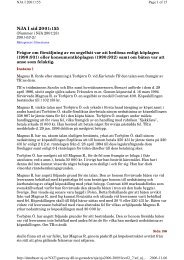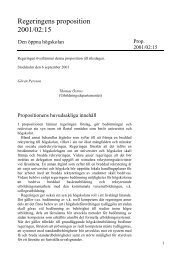A Study of the ITU-T G.729 Speech Coding Algorithm ...
A Study of the ITU-T G.729 Speech Coding Algorithm ...
A Study of the ITU-T G.729 Speech Coding Algorithm ...
You also want an ePaper? Increase the reach of your titles
YUMPU automatically turns print PDFs into web optimized ePapers that Google loves.
Open<br />
MASTER THESIS<br />
Datum - Date Rev Dokumentnr - Document no.<br />
04-09-28 PA1<br />
<strong>of</strong> A(z) is called <strong>the</strong> production filter. Filtering <strong>the</strong> error signal through <strong>the</strong> production filter<br />
yields <strong>the</strong> original signal. This is illustrated in Figure 9.<br />
Figure 9: Production and whitening filter<br />
In order to find <strong>the</strong> optimal predictor coefficients, <strong>the</strong> variance <strong>of</strong> <strong>the</strong> error signal has to<br />
be minimized. This is achieved by differentiating Equation 11 with respect to <strong>the</strong> predictor<br />
coefficients and setting this equal to zero.<br />
α (m) = E[e 2 (n)] (11)<br />
This yields Equation 12, which is known as <strong>the</strong> Yule-Walker equation.<br />
∂α (m)<br />
∂aj<br />
= 0 ⇔<br />
M<br />
akRk(j − k) = RX(j), j = 1, .., M (12)<br />
k=1<br />
If M = 3, <strong>the</strong> Yule-Walker in matrix form is given by<br />
⎛<br />
R(0)<br />
⎝ R(1)<br />
R(1)<br />
R(0)<br />
⎞ ⎛<br />
R(2) a1<br />
R(1) ⎠ ⎝ a2<br />
⎞ ⎛<br />
⎠ = ⎝<br />
R(2) R(1) R(0)<br />
a3<br />
R(1)<br />
R(2)<br />
R(3)<br />
⎞<br />
⎠ (13)<br />
There exist two efficient algorithms for solving <strong>the</strong> Yule-Walker equations and finding <strong>the</strong><br />
optimal predictor coefficients: <strong>the</strong> autocorrelation method and <strong>the</strong> covariance method. In<br />
practice, <strong>the</strong> autocorrelation method is <strong>the</strong> most favored since it returns poles with values<br />
inside <strong>the</strong> unit circle. Thus, it guarantees that <strong>the</strong> production filter is stable. The autocorrelation<br />
method uses <strong>the</strong> computationally fast Levinson-Durbin <strong>Algorithm</strong>. For detailed<br />
information on <strong>the</strong> autocorrelation- and covariance method, <strong>the</strong> interested reader may consult<br />
[13] or [15].<br />
LPC Spectral Analysis<br />
The production filter, H(z), with a gain G is defined by<br />
H(z) = G<br />
A(z)<br />
H(z) is used as <strong>the</strong> vocal tract model in <strong>the</strong> source-filter model, discussed in <strong>the</strong> previous<br />
section. By plotting <strong>the</strong> spectrum for H(z), peaks can be observed that correspond to roots<br />
<strong>of</strong> <strong>the</strong> denominator. The 14th-order LPC spectrum <strong>of</strong> <strong>the</strong> phoneme /ih/, plotted in red, is<br />
depicted in Figure 6. From <strong>the</strong> figure, it can be seen how well <strong>the</strong> envelope matches <strong>the</strong><br />
original signal. This is <strong>the</strong> key to success in LPC.<br />
The choice <strong>of</strong> prediction order is a balance between spectral detail and estimation<br />
error. Also, <strong>the</strong> prediction order depends on <strong>the</strong> sampling frequency, fs. On average, <strong>the</strong>re<br />
(14)<br />
24 (78)





